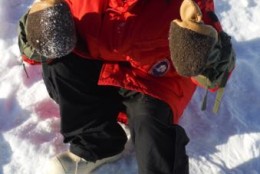





ARLINGTON, Va. — As many of people gear up for vacations at the beach, a local teacher is getting ready for a trip of a lifetime to a very cold place.
Kate Miller, a physics teacher at Washington-Lee High School in Arlington, is scheduled to travel this winter to the bottom of the globe: Antarctica.
Just getting there and staying warm will be a challenge, but the main reason for the trip is a cutting-edge research project.
“I’m really just so excited about all of it,” Miller says.
Called PolarTREC (Teachers and Researchers Exploring and Collaborating), the project provides paid trips for K-12 science teachers to do hands-on field research in the Arctic and Antarctic, and share their experiences and findings with students.
Miller is one of 14 teachers nationwide chosen to take part.
“I’m going to be working on Project Ice Cube at the South Pole, and we are going to be looking at particles coming from outer space. There’s a huge telescope down there that’s actually buried in the ice, to look at these particles,” she says.
The particles are called neutrinos.
“Neutrinos are really great because they’re coming from some of the most violent, but least understood things happening in our universe. Things like stars exploding, going supernova. Things like black holes, which we really don’t know much about. And those neutrinos are like little messengers. They bring us information from these really cool events.”
Miller says it’s a new way of studying the universe, and describes it this way:
“Maybe your head hurts and you go to the doctor. The doctor uses an X-ray to see what’s going on inside. Maybe though the X-ray doesn’t catch something, so he orders an MRI, and the MRI can show really what’s going on. That’s what we’re doing here. We’re looking in a new, different way.”

Miller has already started an online journal that anyone, not just students, can access.
“You can kind of learn alongside me,” she says.
So far, the journal includes details and photos from an orientation she attended in Fairbanks, Alaska, in February.
There, she tested out special cold-weather gear, saw the Northern Lights, and got to hold a very cute hibernating squirrel.
While Miller is at the South Pole, she’s expected to take part in what’s called a Polar Connect event, Internet permitting.
“I will be live video streaming, answering questions from students in classrooms across the U.S.”
The trip will last two to four weeks in December and/or January, when temperatures at the South Pole average about minus 17 degrees Fahrenheit.
Still, Miller says she can’t wait.
“I really like the new, the exciting, the things that make me uncomfortable because that’s when I feel like I’m pushed the most. And what better place to go than the South Pole to have that adventure,” she says.








